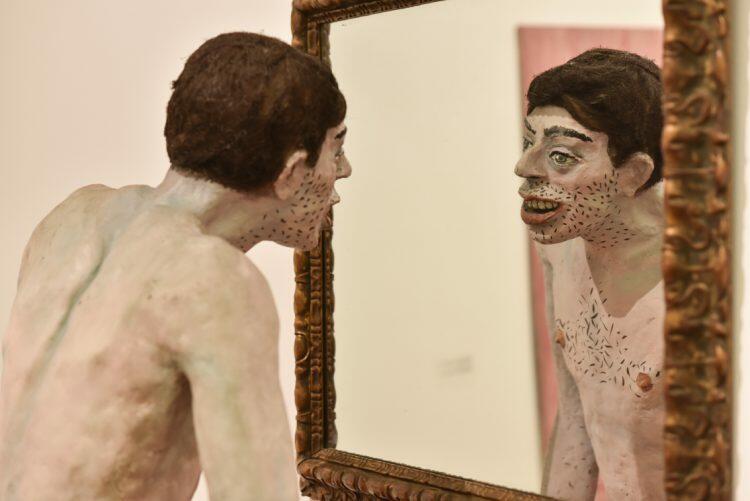NARCISO PLEBEYO: PABLO SUÁREZ AT THE MUSEUM OF LATIN AMERICAN ART OF BUENOS AIRES
Narciso plebeyo is the title chosen for the Pablo Suárez (1937-2006) exhibition curated by Jimena Ferreiro and Rafael Cippolini at the Museum of Latin American Art of Buenos Aires (MALBA). From the part towards the whole, the sculptural installation Narciso de Mataderos (1984-1985) projects as a key to look at the whole of the portrait of a subjectivity, which in each work is imbricated with the folds of a social history. In these folds the plebeian appears as a program of intervention in the art system and as a torsion of the artistic canon. The biographical effect of the exhibition reflects a work of collective memory carried out by those who knew it and contributed to the historical thickness of the exhibition.

We entered that life after a long documentary wall that characterizes the scenarios that Suárez's work configured in Argentine art over four decades that go from 1960 to 2000. From the first images we recognize the secularist and scathing tone that his painting to Molina Campos, Gramajo Gutiérrez and the last Berni. Also from the beginning that popular substrate is implied with an ironic appropriation of the European high tradition: in the iconography, the parodic visit to the topic of Venus in front of the mirror in Muñeca Brava (1964) is the first of a constellation in which Cupid will enter, the effort of Sisyphus and a reptilian fauna with biblical resonances. They are also contraptions consecrated by tradition the use of the symbolic language of the plants and the mise in abyme of illusionism, achieved through unfolding in the representation. It is on this veiledly scholarly background that the local operations of humor and desire are singled out: obstinacy in the practice of the trade and traces of a closer cultural history, even in the neighborhood.
The first of the rooms is a collection of bodies: prostitutes and secretaries contort themselves for a masculine look that directs the scene. Although it is quickly men's bodies that take all the production. The incident twists the generic story of the nude and the humorous codes of the grotesque equally: those of Suárez are bodies made with the proximity of a tactile look. The smooth discourse of the skin is interrupted only where it is punctuated by the incipient hair or pierced by the eyes of an exalted Spilimbergo; the anatomical craftsmanship follows the variable thickness of the skin that falls from the clavicles or that widens and ends on the glandes. Genitality insists under Mannerist backs or between the legs of a portrait in which the depth is constructed, as in a Quatroccento painting, by successive planes of faded color. Suarez seems to save the desire for censorship with the bitter laugh of the artist who knows and trusts the possibilities of his language.
In the next room the scale of the paintings is reduced along with the space that contains them. A private environment - gallery or collector's department - moves the visitor to the retreat imposed by the last dictatorship. In that calm atrocity, a botanist with homemade contours that includes malvones and loops of love casts shades of color tempered by gray and encrypts messages about horror. In the same secluded setting, the next room pierces the eye with old and new realisms: painted crusts and tiles integrated into the pictorial support. The sinister interferes with the silent atmospheres of the paintings that still remind Fortunato Lacámera: the radio victory over the Malvinas war is staged in a modern vanitas, melancholy and everyday. Around, bodies made of absence, abjection or contained aggressiveness.
After the closed enclosure the desire unfolds between matter and flesh in a large sculpture courtyard: intensification of povera luxury and variations on the chongo theme; tails, males and a christ but also colored noodles and resin mixed with yerba. The chongos are now put to work: they dig, they climb, they run away, their eyes desperate pushing the action. In the works of the 90s an urgency also seems to be a symptom in the exasperation of the pictorial matter that accelerates and drags over the support. That desperation appears thematized in the box-object Exclusión (1999), where the train of neoliberalism confines Suárez's chongo to travel in the stirrup. The swallowing of the classical repertoire becomes brilliant in El perla, retrato de un taxy boy (The Pearl, portrait of a taxy boy,1991/1992) vulnerable body, between bloodless and distended, that reminds distantly the idle pose of the Barberini Faun. Also in the Homenaje al cartonero (Cartonero Homage, 2005) we find the rewriting of a classic rest by social history; It is offered to the back view and eaten at the ends by fiberglass. The piece summarizes the plastic intelligence of the artist to inscribe the historicity with a voracious delivery to the possibilities of the materials. With equal intelligence the work of the curators replaces the areas of a biographical space of net but porous perimeters, which is left to be affected by the production of friendly artists and which finds in the forms of plastic enjoyment the sounding board for a plural history.




